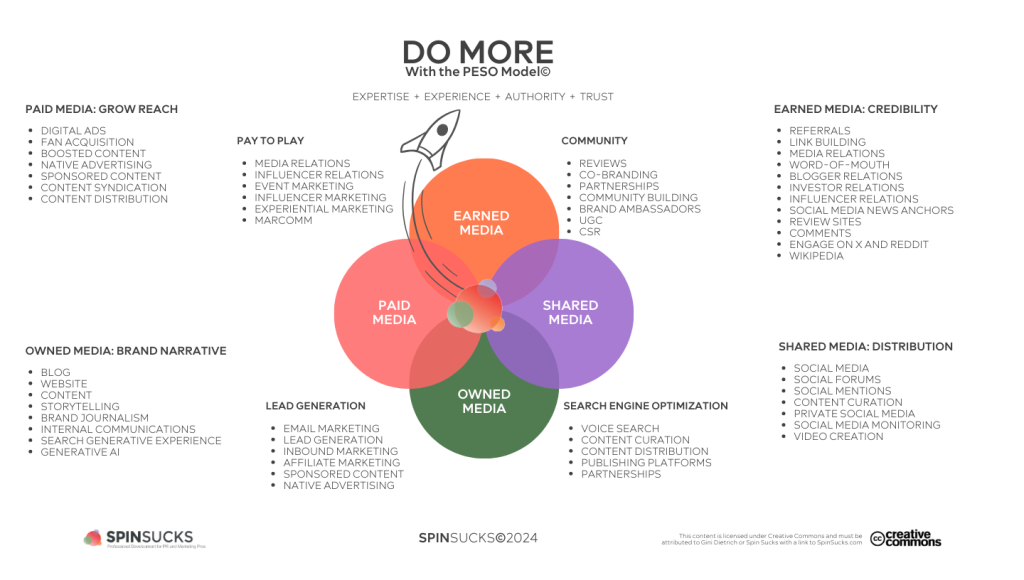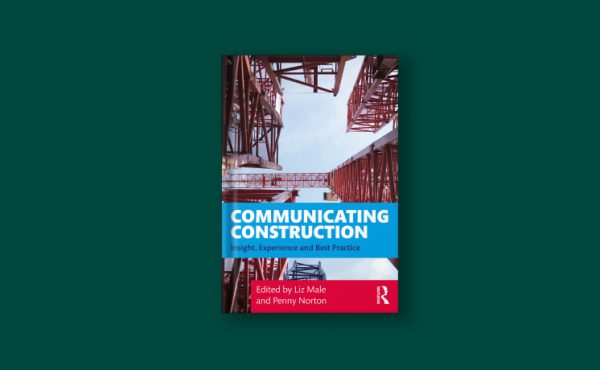In the ever-evolving world of PR and marketing, the PESO Model © provides a clear and effective way of organising and executing successful communication strategies. Though this framework was initially created as a way to measure the impact of public relations and thought leadership media activity, it can also be indispensable for marketing professionals. In this blog, we’ll explore what the PESO Model © is and how it can be applied to build effective PR and marketing campaigns.
Who created the PESO model?
Whilst similar paid, earned, shared, and owned models have been used by other measurement experts, The PESO Model© framework was created by PR consultant, Gini Dietrich, in 2009 for use in her own agency and on her ‘Spin Sucks’ communications blog. It was later released in her 2014 book: ‘Spin Sucks: Communication and Reputation Management in the Digital Age’ which was the foundation for a certification programme in 2020. This framework and graphic was later revamped in 2024 to refine its strategy and also include the impact of evolving technology, such as artificial intelligence (AI) and newer social media platforms like TikTok.
What is the PESO Model?
The PESO Model © is often viewed as a bubble graph which categorises media types into four key areas: Paid, Earned, Shared and Owned. When utilised properly, these four types of media provide a structured way to view the full scope of communication opportunities, help teams optimise every piece of content, plan campaigns that support business objectives and reach a wider audience, in addition to making the most of limited budgets.

Image credit: The PESO Model© use obtained by Spin Sucks.
What defines each section of the PESO Model?
Paid Media
Paid media includes all forms of advertising where you pay to reach an audience, e.g. Google Ads, sponsored social media posts, influencer partnerships, advertorials (TV, radio, magazines), news/press releases (paid placements/colour separations), etc. The scope of paid media is constantly expanding with more platforms and mediums being created to promote messaging, making it even more important to understand the difference between paid and other channels of communication.
Earned Media
Earned media is often considered the most credible form of communication as it relies on excellent media relations. It typically refers to content gained through PR efforts rather than simply paying for it, which means that this type of coverage is often perceived to be more authentic and trustworthy as it is frequently granted on merit. Examples of this include editorial coverage written by a journalist, award recognitions, endorsements, thought leadership (non-paid media placement), speaking/panel discussion invitations, etc. It’s especially advantageous to have specialist knowledge or be known to deliver accurate, reliable information that’s useful for the brand’s industry and audience. If this is the case, journalists may reach out to the brand or the company’s PR and marketing consultancy to offer a feature.
Whilst this is traditionally achieved through good relationships with journalists and public figures, as well as consistently delivering an excellent service and/or high-quality products, the modern digital landscape has generated new avenues for earned media. If there’s an existing article or technical guide, it’s also possible that the company may receive requests from representatives from the media or third-party websites to credit this material. In addition, when reviewing website performance and generating reports, you may also find backlinks to online content, such as blogs, videos, and guide download landing pages. It’s important to note here though, that not all backlinks are created equal. You will need to regularly review them to disavow any spam links, as this can negatively impact domain ranking and performance. Some media and third-party websites have also begun using ‘no follow links’ so a website will not benefit from their authority within search engines. It’s sometimes worth asking about this, though, if you’re aware there will be a credit to content or the website so it can benefit from ‘referral traffic’.
Shared Media
As the name suggests, shared media covers content shared on social media, third-party websites, and community forums. Shared media thrives on engagement, such as comments or reposts, and is typically where a brand directly interacts with its consumers, sparking conversations and starting brand trends.
Owned Media
Owned media covers all the content a brand creates and controls which is useful to the audience, e.g. company website, blogs, articles, email newsletters, whitepapers, webinars, podcasts, etc. This is usually a core part of a brand’s marketing and outreach and often serves as the foundation that other content stems from.
How can you build a communication strategy around the PESO Model?
Dietrich has stated that while it’s called the PESO Model ©, it would make more sense to call it OESP, but that isn’t as catchy and is less likely to be remembered! What Dietrich is indicating is that any communications strategy should be built from informative content that the brand’s audience will find useful and engaging. This can then be rolled out and measured across various media channels.
The real-world application of the PESO Model © might look like this:
- (Owned Media) You write a blog post
- (Earned Media) The content from the blog post is then pitched to journalists and featured as an editorial piece
- (Shared Media) This is distributed to the magazine’s audience on social media
- (Paid Media) Its reach is boosted by a paid campaign via Google Ads, Meta, and/or e-newsletter
This shows how each part of the model supports one another, creating multiple opportunities to deliver the same piece of content and extend your audience. This can increase brand awareness, engagement, and loyalty over time. By separating the model into parts, it also helps identify which types of media are most effective for specific goals.
When using the PESO Model © in a practical application, it is important to ensure the framework is fully integrated into every stage and team that’s involved in inputting into and delivering aspects of a communications strategy. Each media type should influence and improve the other, resulting in a strategic and powerful campaign that’s working towards the bigger picture and supporting the business objectives. For example, a business objective may be to increase sales. The marketing team may create an informative resource, such as a blog or guide, with input from the technical team so that it answers frequently asked questions (FAQs) by customers. This content then becomes useful for the technical and customer service team when handling queries, but it can also help to generate warm leads for the sales team, in addition to being something that could generate earned or shared coverage within the industry.
Using something like the PESO Model © to help integrate traditional PR, marketing, advertising, digital and other creative roles creates a more structured and focused approach which can build brand credibility. There is no ambiguity that could lead to ethical issues. For example, positioning paid-for adverts as editorial or content such as undisclosed influencer marketing campaigns could give the appearance that they are an independent, third-party endorsement, likely violating the CIPR’s Code of Conduct which “emphasises honesty, integrity, and transparency”. By using the PESO Model ©, these would be clearly defined as separate types of marketing.
The example below showcases how the types of media within the PESO Model © work together to create a campaign and how, by defining each type into a set role, it gives a clearer picture of how to deliver a campaign successfully.
- (Owned Media) The technical guide showcases excellent writing, thorough research, and a captivating story that is the foundation of an effective campaign.
- (Earned Media) The guide reaches a wider audience when it is successfully pitched to journalists who will find the information valuable to their magazine or website visitors. This may be developed into an interview or thought leadership article that links back to the owned content, helping to increase referral traffic, domain ranking, improve brand awareness/market share, and potentially develop queries or leads for the sales team.
- (Shared Media) The content is used on social media over a longer period, extending the reach and engagement with blog teasers, behind-the-scenes of the interview, cut into shorter LinkedIn posts, and even turned into polls to encourage active discussion amongst audiences. These posts help to generate additional referral traffic, improve brand awareness, potentially attract brand advocates, and with the possibility of also generating more queries or leads for the sales team.
- (Paid Media) Content may be boosted based on what is driving interest organically, and the audience is targeted based on relevant engagement. This can be done through Google Ads and retargeting campaigns for the website landing page, sponsoring popular social posts, or including in paid e-newsletters.
How has AI influenced the PESO Model?
The integration of AI into the PESO Model © has been a gradual process, with a noticeable increase in its adoption since 2014. Leveraging AI can support content creation, analysis, and audience targeting within each media type.
Paid Media
AI can be utilised to create audience models using first-party data or collating email lists, a task that would have previously taken a large chunk of time to do manually. Some AI models even have options to filter specific target audiences. This can be especially useful for the construction industry, as many roles have vastly different duties; being able to target segmented audiences can be extremely useful when positioning a brand’s marketing. Of course, knowing who to target and which messages will resonate with an audience still relies on a person’s expertise, but AI can support and simplify the process.
Earned Media
It is commonly understood that earned media is reserved for human connections, and as the name suggests, ‘earning’ your place in the media. Journalists have reported that they are now receiving more pitches using AI tools than ever before. However, they claim that what makes them open an email and engage with it is their relationship with the sender. They also report that it is easy to spot when AI has been used to write a pitch, compared to a well-crafted, genuine pitch that is more likely to gain recognition. In some instances, AI can contribute to earned media activity, whether that be through creating a first draft that is edited into a personal style or tracking coverage and predicting pitching trends. Though it’s often being unique, genuine, and developing interpersonal relationships with journalists that will always be paramount to earned media.
What may be worth keeping an eye on is the impact of AI search summaries, particularly as part of the research process, and how this may impact the sources being cited going forwards. Digital content that is AI Search Engine Optimised (AI SEO) is more likely to be picked up in these AI summaries. Whilst it’s difficult to measure or track whether content appears in an AI summary, it may mean well-optimised content is more likely to be cited in articles, guides, and other authoritative pieces which can be tracked and reported on as brand mentions, traffic, backlinks, etc.
Shared Media
Shared media is the PESO area most suited to integrating AI tools, helping to increase visibility and connection with audiences. Social media platforms are starting to use AI tools to analyse performance data, identifying key trends and opportunities. We have frequently seen AI used to create ‘skeleton’ social posts or generate images. Whilst these tools can help increase brand visibility and encourage engagement/sharing of content, it’s important there is still human oversight to ensure that any content it creates closely matches brand voice and ethos. In addition, that any copy or visual assets are accurate and don’t become viral for the wrong reasons.
Many media monitoring tools are also starting to utilise AI, such as tracking conversations and public opinion in real time, which allows brands to report on brand mentions as well as potentially plan when to engage with specific topics. This has historically been difficult to gauge or time-consuming to manually monitor, as poorly timed engagement with online conversations or trends can be detrimental to a brand. Summaries of online brand mentions and keywords can now be automated and scheduled to come straight to an inbox.
Owned Media
Owned media is possibly the trickiest PESO section to apply AI to. Questions arise, such as: Should AI be introduced into the creative process? Should written and visual work remain completely human to protect artistic integrity? If AI is used to create pieces of work, then who has intellectual copyright?
It is generally recognised that AI can be useful in supporting some creative processes and production, but it should be used primarily as an assisting tool, and not for creating the finished product. For example, using AI to help research, structure a first draft, list key points, or summarise a large body of text can be extremely helpful when writing, especially when working to a tight deadline. But this should then be worked from to be made more human and still include aspects of the brand’s tone, style, and persona. It’s also essential to verify all sources and information gathered through AI, as it can be inaccurate. Likewise, in the development of visual assets, AI tools can be helpful for visual ideation or tasks such as extending image backgrounds, but the skills, knowledge, and contextual understanding of a human designer are needed to hone a finished product.
Final thoughts
Many clients we’ve worked with are very busy and are experiencing increasing pressure from the board to demonstrate return on investment (ROI) to protect their budgets. They rely on us and our expertise as an established PR and marketing consultancy to help create engaging and informative communications strategies that support business growth and meet the high expectations of their customers. We can then use our knowledge, skills, and relationships within the industry as a trusted construction public relations and marketing consultancy to help our clients increase their audience reach.
The PESO Model © is an example of how a campaign can be structured to help create a clearly defined strategy, which can ensure the brand is reaching its intended audience, and a campaign can be effectively measured to report on its impact.
If you’re looking for support in developing a successful PR and marketing strategy for your built environment business, we can help. Get in touch to arrange a no-obligation discussion with our team.





